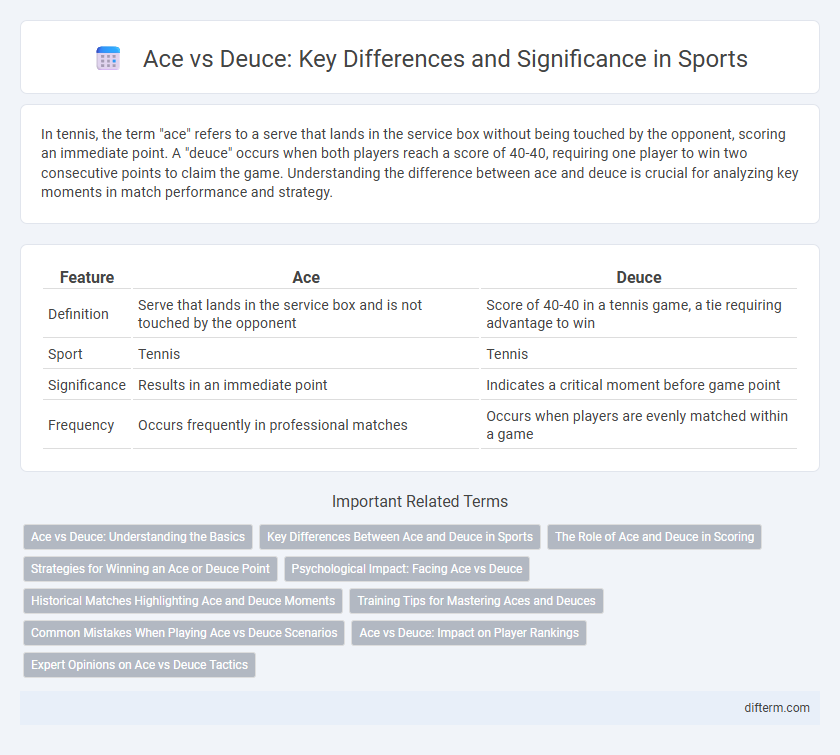In tennis, the term "ace" refers to a serve that lands in the service box without being touched by the opponent, scoring an immediate point. A "deuce" occurs when both players reach a score of 40-40, requiring one player to win two consecutive points to claim the game. Understanding the difference between ace and deuce is crucial for analyzing key moments in match performance and strategy.
Table of Comparison
| Feature | Ace | Deuce |
|---|---|---|
| Definition | Serve that lands in the service box and is not touched by the opponent | Score of 40-40 in a tennis game, a tie requiring advantage to win |
| Sport | Tennis | Tennis |
| Significance | Results in an immediate point | Indicates a critical moment before game point |
| Frequency | Occurs frequently in professional matches | Occurs when players are evenly matched within a game |
Ace vs Deuce: Understanding the Basics
Ace and deuce are fundamental terms in tennis, where an ace refers to a serve that lands in the service box and is untouched by the opponent, scoring a point outright. Deuce occurs when both players reach a score of 40-40, requiring a player to win two consecutive points to secure the game. Mastery of serving aces can provide a significant advantage, while understanding the strategy during deuce points is crucial for clinching tightly contested games.
Key Differences Between Ace and Deuce in Sports
An ace in tennis is a serve that lands in the service box and is untouched by the opponent, immediately winning the point. A deuce occurs when both players reach a score of 40-40, requiring one player to win two consecutive points to secure the game. The ace emphasizes powerful serving skills, while the deuce highlights a tightly contested, evenly matched game situation.
The Role of Ace and Deuce in Scoring
Ace and deuce play crucial roles in tennis scoring, with an ace serving as a powerful, unreturned serve that awards the server a point immediately. A deuce occurs when both players reach 40-40, creating a high-pressure situation requiring a player to secure two consecutive points to win the game. Understanding the dynamics of ace and deuce is essential for interpreting momentum shifts and strategic plays during matches.
Strategies for Winning an Ace or Deuce Point
Maximizing the chances of winning an ace point involves mastering serve speed, placement, and spin to outmaneuver the opponent's return. In contrast, strategies for winning a deuce point emphasize mental resilience, tactical shot selection, and exploiting opponents' weaknesses during prolonged rallies. Effective utilization of these strategies significantly increases success rates in crucial tennis matches.
Psychological Impact: Facing Ace vs Deuce
Facing an ace in tennis generates immediate psychological pressure due to the opponent's dominant serve, often causing heightened anxiety and a defensive mindset. In contrast, facing a deuce situation increases mental endurance as players grapple with the equal score, emphasizing focus and strategic play to gain a crucial advantage. The psychological impact in high-stakes matches reveals that aces can intimidate, while deuces test resilience and composure under pressure.
Historical Matches Highlighting Ace and Deuce Moments
Historic tennis matches often hinge on pivotal ace and deuce moments that shift momentum and define champions. Legendary players like Pete Sampras and Serena Williams have famously turned matches around with crucial aces, while intense deuce battles in Grand Slam finals showcase the sport's mental and physical endurance. These electrifying points remain etched in tennis history, highlighting the drama and skill essential to competition at the highest level.
Training Tips for Mastering Aces and Deuces
Mastering aces and deuces requires focused training on serving technique, including consistent ball toss, racket speed, and proper body rotation to generate power and precision. Incorporate drills that simulate match conditions, such as practicing various serve placements and angles to exploit opponents' weaknesses. Regular video analysis and feedback help identify mechanical flaws, allowing targeted adjustments to improve serve effectiveness and increase ace counts.
Common Mistakes When Playing Ace vs Deuce Scenarios
Common mistakes in ace vs deuce scenarios include misjudging the opponent's serving patterns and underestimating the speed and placement of the ace, leading to poor return positioning. Players often fail to maintain proper footwork and timing, resulting in weak returns that give the server an advantage. Another frequent error is neglecting to anticipate and react to the subtle variations in the deuce court's angles, which can lead to unforced errors and lost points.
Ace vs Deuce: Impact on Player Rankings
Ace versus deuce statistics significantly influence player rankings by reflecting serving efficiency and pressure performance. High ace counts correlate with increased service game wins, directly boosting ranking points in competitive tennis. Conversely, minimizing double faults, including deuces lost, helps maintain consistency, preventing ranking drops due to unforced errors.
Expert Opinions on Ace vs Deuce Tactics
Expert opinions on ace vs deuce tactics emphasize the strategic advantage of targeting the deuce court to exploit players' backhand weaknesses, while aces often serve as pivotal points to assert dominance and pressure opponents. Coaches highlight the importance of varying serve placement and speed to disrupt rhythm, especially in high-stakes matches where ace percentages can decisively shift momentum. Statistical analyses reveal that players with high ace rates on the deuce side tend to generate more unreturnable serves, enhancing their overall service game effectiveness.
ace vs deuce Infographic

 difterm.com
difterm.com